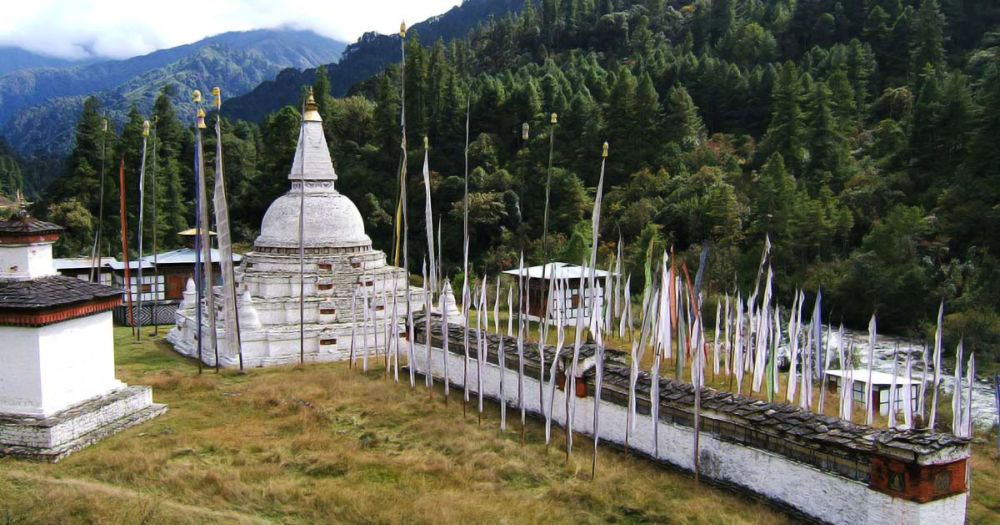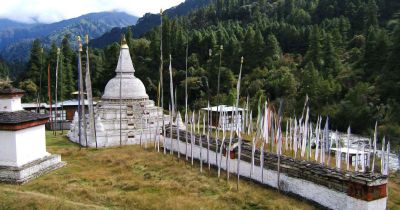

The Chendebji Chorten is an important stupa located in the heart of Bhutan, near the town of Trongsa. It was built in the 18th century by Lama Shida, to cover the remains of an evil spirit that was subjugated at this spot. The stupa is patterned on Kathmandu’s Swayambhunath Stupa, with eyes painted at the four cardinal points. It sits amidst a picturesque landscape, with a backdrop of mountains and the sound of a nearby river creating a peaceful atmosphere for visitors. The area around the Chorten is perfect for meditation and for taking a break from the hustle of travel. Visitors can enjoy the intricate mandala patterns, prayer wheels, and the collection of prayer flags that flutter in the wind. Locals often come here to perform circumambulations and to pray for good fortune.
Trongsa Dzong is a significant fortress in Bhutan, commanding the landscape from a strategic position above the Mangde River. It is traditionally the place where the investiture ceremony of the new king is held before ascending the throne, and is thus a site steeped in royal heritage. Built in the mid-17th century, this magnificent dzong is an architectural marvel, featuring multiple levels that are connected by a maze of courtyards and passageways. The visit to Trongsa Dzong allows you to explore the rich history of Bhutan while admiring the stunning architecture and beautiful location. The dzong also houses a museum which offers insight into the traditions and culture of the kingdom, displaying ancient artifacts, religious statues, and elaborate thangka paintings.
The hike to the historic Kuenga Rabten Palace provides a glimpse into the winter retreat for the second king of Bhutan. Situated approximately 23 kilometers from Trongsa, the journey is as captivating as the destination, with the trail winding through verdant forested areas and rural landscapes. You'll encounter farmers working the fields and see traditional Bhutanese life unfold. The palace itself, although less grand than some of the major dzongs, offers a more intimate experience of Bhutanese royalty, set against a pastoral backdrop. Inside, the palace displays original furniture and offers insights into the history of the monarchy. The hike is moderately easy and presents a chance to stretch your legs while delving into the country's royal past.
Ta Dzong, once a watchtower built to defend Trongsa Dzong, has now been transformed into a museum dedicated to the Wangchuck dynasty. A visit to the Ta Dzong Museum provides a profound understanding of Bhutan's royal history over five generations. The museum houses a number of historical artifacts, including royal memorabilia, ancient battle gear, and a collection of adornments that reflect Bhutan's rich cultural heritage. With its prime location overlooking Trongsa Dzong, the views from the museum are equally awe-inspiring. The exhibitions are well-curated, and visitors will leave with a greater appreciation of the role that this fortress played in Bhutan's history. Expert guides are often available to explain the significance of the exhibits.
Archery is Bhutan's national sport and a visit to Trongsa offers a unique opportunity to experience this aspect of Bhutanese culture. Various archery ranges can be found where locals gather to compete, often during festivals or on weekends. Visitors can watch seasoned archers display their skills with traditional bamboo bows and arrows. For those interested in trying their hand at the sport, there are introductory sessions available guided by local archers. These sessions provide insight into the technique, the significance of archery in Bhutanese society, and an opportunity to participate in a traditional pastime. The experience is fun and engaging, offering a chance to interact with locals in a jovial and festive atmosphere.
Bhutanese cuisine is rich with spicy flavors and distinctive dishes that reflect the country's unique culture. While in Trongsa, take the opportunity to sample local culinary delights such as Ema Datshi (chili and cheese), Phaksha Paa (pork with red chilies), and Momos (dumplings). Many local eateries and restaurants around Chendebji and Trongsa offer authentic Bhutanese meals prepared with fresh, local ingredients. Food tours or cooking classes are sometimes available, providing a hands-on experience that allows visitors to not only taste but also learn how to prepare traditional Bhutanese dishes. Experiencing the local cuisine is a memorable way to connect with the culture and traditions of Bhutan.
After a long day of exploring, indulge in the traditional Bhutanese hot stone bath known as 'Dotsho'. This therapeutic experience involves soaking in a wooden tub while water is heated by river stones that have been roasted in a fire, releasing key minerals. The heat from the stones releases minerals into the water, believed to have healing properties that can alleviate muscle aches, improve circulation, and ease various ailments. Typically, local herbs are added to the water for their aromatic and medicinal properties. This traditional bath provides a relaxing and cultural experience, offering insight into an age-old Bhutanese wellness practice. It is a perfect way to unwind and rejuvenate in the tranquility of Trongsa's natural surroundings.
For a truly immersive experience in Bhutanese culture, consider a homestay in a village near Chendebji Chorten. This opportunity allows visitors to live with a local family, participate in their daily activities, and understand their way of life. You can join in on agricultural activities, learn how to cook Bhutanese dishes, and participate in evening prayers. Homestays provide a unique perspective into the Bhutanese people’s hospitality and their harmonious lifestyle that blends with nature. Sleeping arrangements are typically simple but comfortable, and the connection made with the host family can be one of the most rewarding experiences of visiting Bhutan.
Cycling is a fantastic way to explore the scenic landscape around Trongsa and Chendebji Chorten at your own pace. Rent a bike and pedal through the winding roads surrounded by pristine forests and traditional villages. Biking offers a sense of freedom and closeness to nature that is hard to achieve with other modes of transportation. You can visit local attractions, stop for photos, or chat with villagers along the way. Various shops in Trongsa offer mountain bikes for rent, and you can choose from half-day to full-day rentals. For the more adventurous, there are challenging routes that provide an exhilarating biking experience within the mystical beauty of Bhutan.
Trongsa and its surroundings offer the perfect setting for a spiritual retreat. Various monasteries and retreat centers host meditation sessions, yoga classes, and spiritual teachings. These activities aim to provide serenity and introspection amidst the tranquil environment of Bhutan. With the majestic Chendebji Chorten as a backdrop, participants can explore their inner peace and learn about Buddhist philosophy and practices. The retreats can range from a few hours to multiple days, offering a chance to disconnect from the distractions of modern life and reconnect with one's spiritual self. In the presence of lamas and spiritual teachers, one can delve deeper into mindfulness and enhance their well-being.
